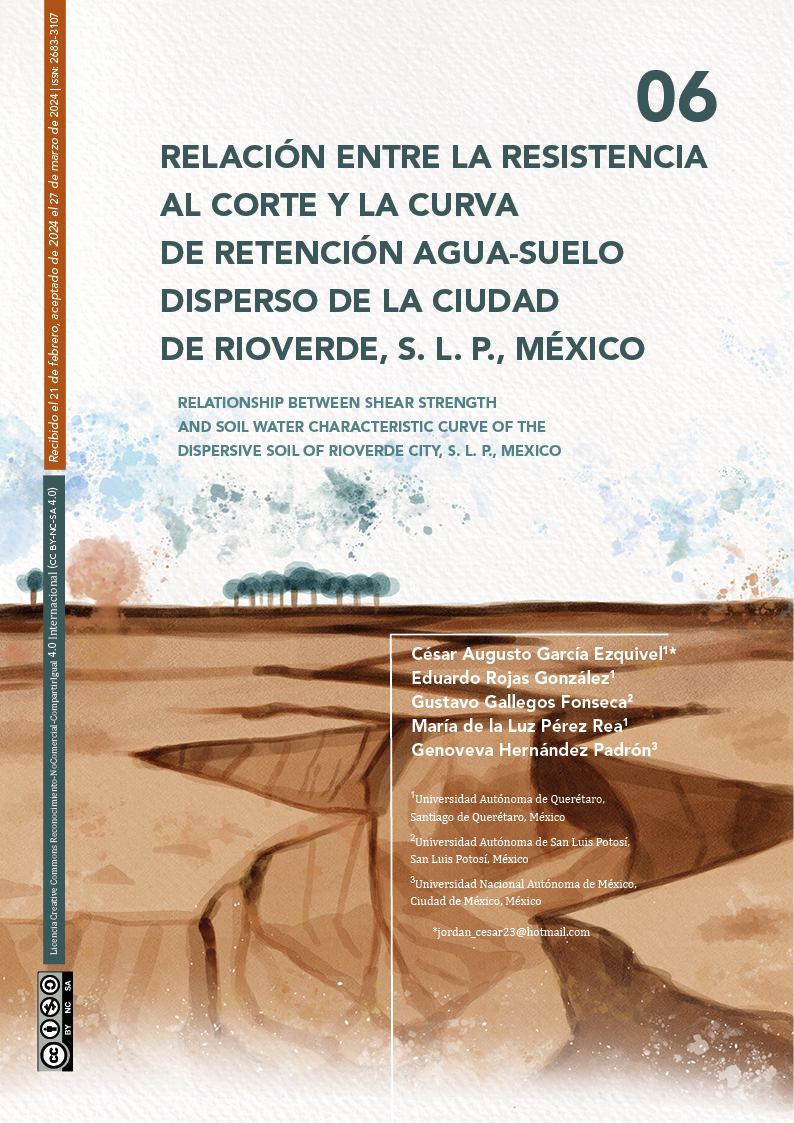Abstract
Classical soil mechanics is developed with the study of saturated soils. With it, constitutive models are established that can explain the mechanical and volumetric behavior of these two-phase systems based on Terzaghi's effective stress principle. However, in a large part of the earth's surface there are soils in an unsaturated state that present unusual behaviors. The shear strenght parameters that define the failure envelope of unsaturated soils are: effective cohesion (c´), effective friction angle (φ´) and change in shear resistance generated by change in matric suction. (φb). These parameters are important for slope stability analysis and foundation design. This article presents a series of Consolidated-Drained triaxial tests at different degrees of saturation, which were carried out in a wetting trajectory in a soil with dispersive characteristics in the city of Rioverde, S.L.P., México. The water-soil retention curve is determined for both drying and wetting trajectories with the filter paper technique. The results are presented in diagrams of effective stress vs. deviator stress (p´- q´), deviator stress vs. suction (q´-S), degree of saturation vs. effective friction angle (Sw – φ´) and degree of saturation vs. effective cohesion (Sw – c´). It is observed that the soil under study reaches a maximum resistance for a suction of 2000 kpa and is reduced by 60% for higher suction values.
References
J. Leal-Vaca, G. Gallegos-Fonseca, and E. Rojas, “Estimación de esfuerzos efectivos a partir del parámetro χ de Bishop en una arena limosa,” Ing. Investig. y Tecnol., vol. 14, pp. 139–151, 2013, doi: 10.1016/S1405-7743(13)72232-7.
M. A. Alfaro Soto, “Geotecnia en suelos no saturados,” 2008.
J.-L. Briaud, “Geotechnical engineering: unsaturated and saturated soils.” John Wiley & Sons, 2013.
T. Mohammad, B. Huat, F. Ali, and H. S, “Relationship Between Shear Strength and Soil Water Characteristic Curve of an Unsaturated Granitic Residual Soil,” Am. J. Environ. Sci., vol. 2, 2006, doi: 10.3844/ajessp.2006.142.145.
J. Burland and J. Jennings, “Limitations to the Use of Effective Stresses in Partly Saturated Soils,” Geotechnique, vol. 12, pp. 125–144, 1962, doi: 10.1680/geot.1962.12.2.125.
N. Lu and W. J. Likos, “Suction Stress Characteristic Curve for Unsaturated Soil,” Journal of Geotechnical and Geoenvironmental Engineering, vol. 132, no. 2. pp. 131–142, 2006. doi: 10.1061/(asce)1090-0241(2006)132:2(131).
C. I. Verdin Montes, “Modelacion de suelos expansivos mediante esfuerzos efectivos,” 2018.
M. Tuller and D. Or, “Retention of water in soil and the soil water characteristic curve,” Encyclopedia of soils in the environment, vol. 4. pp. 278–289, 2004. [Online]. Available: http://www.engr.uconn.edu/environ/envphys/pdf/vadose_pdf/SWC_revised01.pdf
W. Albadri, M. J. Md Noor, and I. Alhani, “The relationship between the shear strength and water retention curve of unsaturated sand at different hydraulic phases,” Acta Geotech., vol. 16, pp. 1–15, 2021, doi: 10.1007/s11440-021-01189-7.
J. Ramírez Jiménez, “Influencia de los ciclos de histeresis en el comportamiento mecanico de un suelo no saturado.” 2020.
C. A. Garcia Ezquivel, E. Rojas González, and G. Gallegos Fonseca, “Determination of the dispersive properties of the soil of Rioverde city, Mexico,” Memorias del XIX Int. Eng. Congr., 2023.
ASTM D5298-10, “Measurement of Soil Potential (Suction) Using Filter Paper,” ASTM Int., 2010.
ASTM D7181-11, “Standard Test Method for Consolidated Drained Triaxial Compression Test for Soils,” ASTM Int., 2011.

This work is licensed under a Creative Commons Attribution-NonCommercial-ShareAlike 4.0 International License.
Copyright (c) 2024 Perspectivas de la Ciencia y la Tecnología


